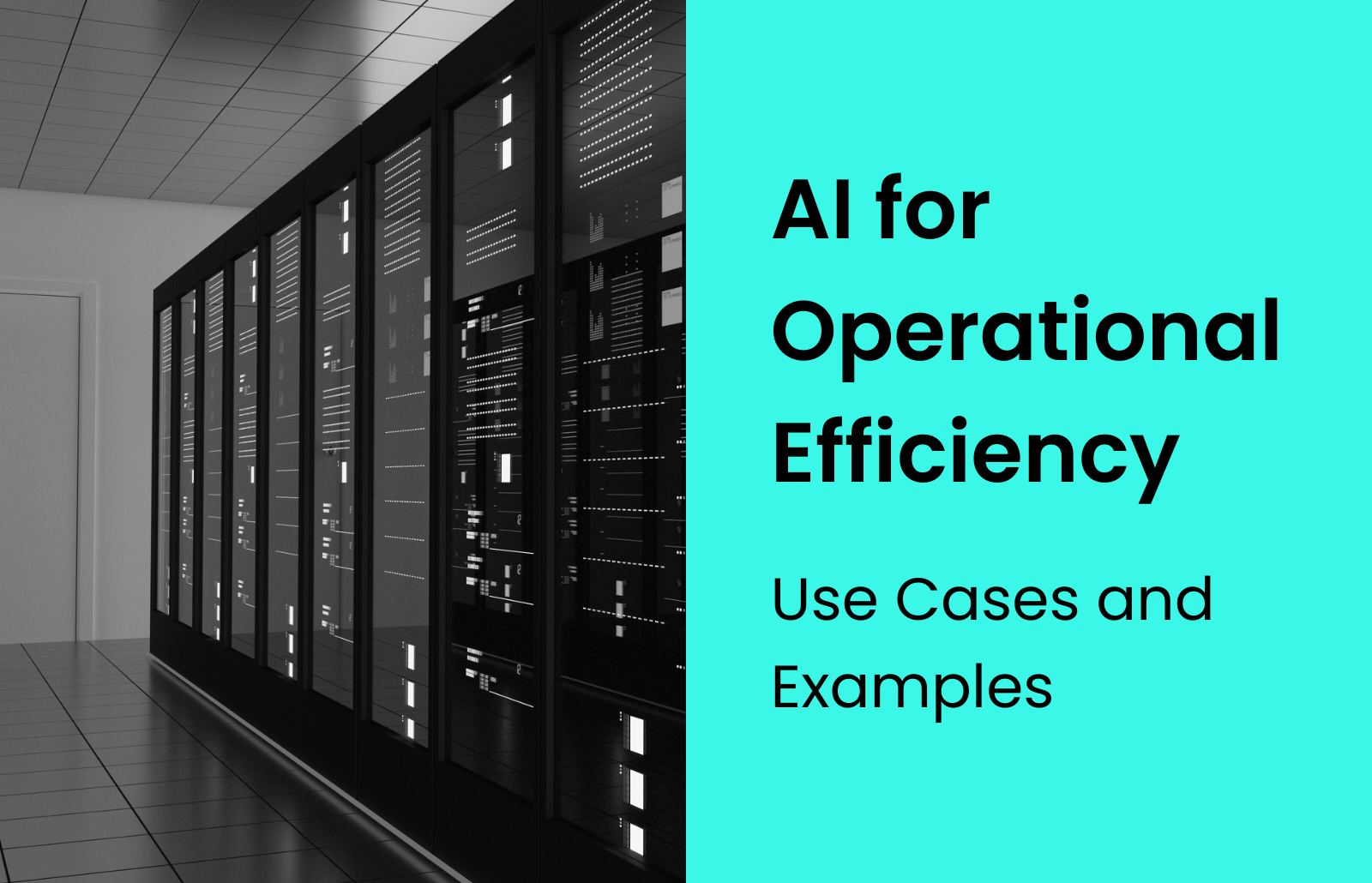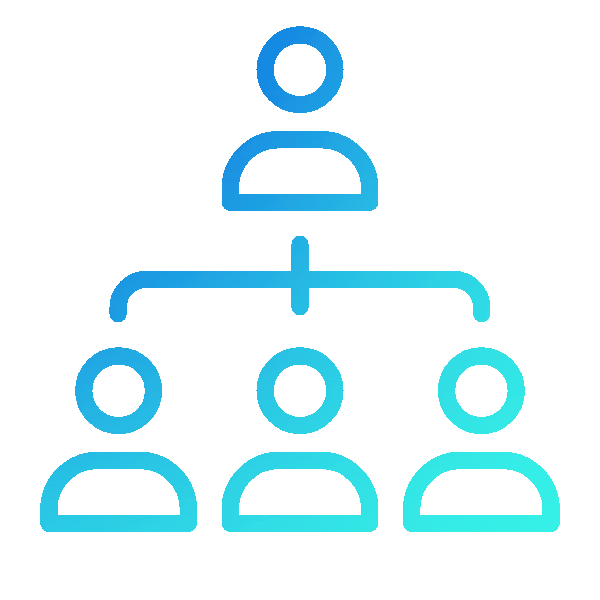Feeling frustrated because of repetitive tasks and inefficient processes? AI can be your secret weapon for streamlining operations across your entire business. Imagine a world where everyday tasks are handled automatically, resources are allocated perfectly, and you can anticipate problems before they arise. That’s the power of AI for operational efficiency.
Here, we’ll showcase how AI is revolutionising efficiency in key areas like software development, HR, operations, and finance. We’ll focus on practical use cases that deliver real results, from automating repetitive tasks to optimising resource allocation and slashing processing times.
This blog is your roadmap to unlocking the true potential of AI for operational efficiency. We’ll provide clear-cut examples and practical guidance to help you implement AI solutions that drive real performance improvements in your business. Get ready to discover how AI can help you!
AI for Operational Efficiency: What it Means
AI for operational efficiency refers to the application of artificial intelligence and machine learning technologies to optimise and streamline business processes, leading to improved productivity, reduced costs, and enhanced customer satisfaction. The goal is to automate and augment various operational tasks, freeing up human resources for more strategic and creative work.
Harnessing AI for Operational Efficiency: Use Cases Across Industries
Let’s explore how AI is being used in software development, HR, operations, and finance to simplify tasks and get things done faster!
1. Software Development: Supercharge Your Development Cycle with AI
The world of software development is a constant race against time and complexity. AI can be a game-changer, injecting intelligence into your development process and empowering your team to achieve more. Here’s a deeper dive into how AI can revolutionise software development:
i) AI-powered Code Completion: Your Intelligent Coding Partner
Imagine having a coding partner who anticipates your next move! AI-powered code completion tools do just that. By analysing your code structure and the context of your project, these tools can suggest relevant code snippets, function calls, and variable names. This significantly reduces the time spent on repetitive coding tasks, allowing developers to focus on the creative aspects of problem-solving and architectural design.
Benefits of AI-powered Code Completion
- Increased Development Speed: Developers can write code faster with fewer syntax errors, leading to quicker development cycles and faster time-to-market.
- Improved Code Quality: AI suggestions often adhere to best practices and coding conventions, leading to cleaner and more maintainable code.
- Reduced Cognitive Load: By automating repetitive tasks, AI frees up mental space for developers to focus on complex logic and problem-solving.
ii) Automated Code Review: Catch Bugs Early and Often
Code reviews are crucial for ensuring code quality and catching potential bugs. However, manual code reviews can be time-consuming and prone to human error. AI-powered code review tools can automate this process by analysing code for common errors, stylistic inconsistencies, and potential security vulnerabilities. These tools can highlight areas that might require further scrutiny, allowing developers to focus on fixing critical issues.
Benefits of Automated Code Review
- Early Bug Detection: AI can identify potential bugs even before they manifest, saving valuable debugging time and reducing the risk of regressions.
- Improved Code Consistency: AI can enforce coding standards and best practices, leading to more consistent and maintainable code across the codebase.
- Frees Up Developer Time: By automating repetitive review tasks, AI allows developers to focus on more strategic work like design and feature development.
iii) Intelligent Bug Detection: Proactive Problem Prevention
Debugging can be a frustrating and time-consuming process. AI can take the guesswork out of debugging by analysing code patterns and historical bug data. These intelligent tools can predict potential bugs before they occur, allowing developers to proactively address issues and prevent them from impacting functionality.
Benefits of Intelligent Bug Detection
- Reduced Debugging Time: By pinpointing potential issues early on, AI can significantly reduce the time spent debugging and resolving issues.
- Improved Code Quality: Proactive bug detection helps to prevent bugs from reaching production, leading to a more stable and reliable software product.
- Enhanced Development Efficiency: By eliminating the need to hunt for bugs, AI streamlines the development process and increases overall efficiency.
The Future of AI in Software Development
AI is still evolving in the software development landscape, but its potential is undeniable. As AI tools become more sophisticated, we can expect even greater advancements in areas like:
- Automated Testing: AI-powered tools can create more comprehensive and targeted automated test suites, improving test coverage and reducing manual testing efforts.
- Self-Learning Code: AI-powered code could potentially learn and adapt over time, optimising itself for performance and efficiency.
By embracing AI in software development, businesses can unlock a new era of speed, efficiency, and quality.
2. Human Resources (HR): Revolutionising Recruitment and Retention with AI
The impact of AI on HR is nothing short of transformative. By automating repetitive tasks and leveraging data-driven insights, AI empowers HR teams to focus on strategic initiatives and create a more positive employee experience. Here’s a deeper dive into how AI is revolutionising HR in two key areas:
i) Supercharged Recruitment: From Sourcing to Selection
- AI-powered Resume Screening: Imagine eliminating the tedious task of manually sifting through hundreds of resumes. AI can scan resumes based on predefined criteria (skills, experience, keywords) and identify candidates who closely match the job description. This significantly reduces time spent on unqualified applicants and allows recruiters to focus on high-potential candidates.
- Predictive Hiring: AI can analyse historical hiring data to identify patterns that predict successful employees. This can include factors like previous job performance, educational background, and even specific skills listed on resumes. By using these insights, HR teams can make more informed hiring decisions and improve the quality of new hires.
- Chatbots for Candidate Engagement: AI-powered chatbots can automate initial interactions with potential candidates, answering frequently asked questions about the company, culture, and job role. This provides candidates with a convenient and personalised experience while freeing up HR professionals for more strategic tasks.
- Automated Interview Scheduling: Scheduling interviews can be a time-consuming back-and-forth between candidates and recruiters. AI can streamline this process by offering candidates flexible interview slots through a user-friendly interface. This not only improves the candidate experience but also ensures faster interview scheduling.
ii) Seamless Onboarding: Setting New Hires Up for Success
- AI-powered Onboarding Chatbots: Onboarding new hires can involve a lot of paperwork and information overload. AI chatbots can be a valuable resource for new employees, providing them with 24/7 access to answers to common questions, company policies, and benefit information. This reduces the burden on HR personnel and ensures new hires have the information they need to feel comfortable and productive from day one.
- Personalised Learning Paths: AI can analyse an employee’s role, skills, and learning goals to recommend personalised training materials and development opportunities. This targeted approach ensures employees receive the most relevant training, accelerating their ramp-up time and boosting their skills.
- Sentiment Analysis: AI can analyse employee communications (emails, surveys) to identify potential issues with onboarding or employee satisfaction. By catching concerns early on, HR teams can proactively address them and improve the overall onboarding experience.
By leveraging these AI-powered solutions, HR departments can significantly improve their efficiency, attract top talent, and foster a positive employee experience throughout the entire recruitment and onboarding process.
3. Operations: Unleashing Efficiency with AI
The world of operations is ripe for AI-powered transformation. Here’s how AI can revolutionise your operational processes:
i) Automated Workflows: Beyond the Mundane
Imagine a world where data entry, report generation, and email distribution happen seamlessly, without human intervention. AI can handle these repetitive tasks with incredible accuracy and speed. This frees up your valuable operations staff to focus on higher-level activities like:
- Strategic Planning and Process Improvement: Your team can analyse operational data and identify areas for optimisation. AI can then automate these improvements, streamlining workflows for long-term efficiency gains.
- Exception Handling and Problem-Solving: By automating routine tasks, AI allows your team to focus on exceptions and unexpected issues. They can leverage their expertise to troubleshoot complex problems and ensure smooth operations.
- Customer Service Excellence: With AI handling routine tasks, your team can dedicate more time to customer interactions. They can provide personalised support and resolve customer inquiries efficiently, enhancing customer satisfaction.
ii) Predictive Maintenance: Preventing Problems Before They Arise
Imagine having a crystal ball for your equipment. AI-powered predictive maintenance makes this a reality. Here’s how it works:
- Sensor Data Analysis: Sensors embedded in machinery continuously collect data on performance parameters like temperature, vibration, and energy consumption.
- AI-powered Anomaly Detection: AI algorithms analyse this sensor data in real-time, identifying subtle deviations from normal operating patterns.
- Predictive Insights and Actionable Alerts: The AI system can predict equipment failures well before they occur, alerting operations teams to potential issues.
- Proactive Maintenance: With this advanced warning, your team can schedule preventative maintenance interventions, minimising downtime, repair costs, and production disruptions.
The benefits extend beyond preventing costly breakdowns. Predictive maintenance allows for:
- Optimised Resource Allocation: By scheduling maintenance during planned downtime, you can optimise the use of your maintenance personnel and resources.
- Extended Equipment Lifespan: Catching and addressing potential issues early on prevents major breakdowns and extends the lifespan of your valuable equipment.
- Improved Safety: Predictive maintenance reduces the risk of unexpected equipment failures, creating a safer work environment for your employees.
AI empowers operations teams to move from reactive problem-solving to proactive efficiency. By automating routine tasks and enabling predictive maintenance, AI unlocks a new era of operational excellence.
4. Dive Deeper: AI in Finance
The financial sector, traditionally known for its meticulous processes and cautious approach, is undergoing a revolution driven by Artificial Intelligence (AI). From automating tedious tasks to safeguarding against fraud, AI is streamlining operations, empowering smarter decisions, and unlocking a new era of financial efficiency. Let’s delve into some concrete examples of how AI is transforming the world of finance:
i) Automated Invoice Processing: Unleashing Efficiency from the Paper Chase
Imagine a world where chasing down invoices and manually entering data becomes a relic of the past. AI is making this a reality through a multi-pronged approach:
- Optical Character Recognition (OCR) on Steroids: Gone are the days of manually keying in invoice data. AI-powered OCR can now accurately extract information like vendor names, invoice amounts, and due dates from scanned invoices, PDFs, and even photographs. This eliminates the risk of human error and streamlines data entry.
- Intelligent Classification: Sorting the Wheat from the Chaff: AI doesn’t stop at data extraction; it can categorise invoices based on type (rent, utilities, office supplies) or department. This intelligent sorting ensures invoices are routed for the appropriate approvals, eliminating delays and confusion.
- Smart Matching: Marrying Invoices with Purchase Orders – Seamlessly: No more hunting for purchase orders to match invoices. AI can automatically match invoices with corresponding purchase orders, verifying details like quantities and prices. This ensures payments are made to the right vendors for the correct amounts, preventing costly errors.
- Exception Handling: Flagging Discrepancies Proactively: AI acts as a vigilant watchdog, identifying inconsistencies between invoices and purchase orders. For instance, it can detect discrepancies in quantities or pricing, flagging these exceptions for human review and preventing potential payment issues.
The Benefits of AI-Powered Invoice Processing Are Undeniable
- Reduced Processing Time: Invoices are processed and paid significantly faster, improving cash flow and supplier relationships.
- Enhanced Accuracy: AI minimises human error in data entry, leading to more accurate payments and financial records.
- Cost Savings: Automation frees up staff from tedious tasks, allowing them to focus on more strategic financial activities.
ii) Fraud Detection and Risk Management: Building Fortresses Against Financial Crime
Financial fraud is a persistent threat, costing businesses billions of dollars annually. AI is emerging as a powerful weapon in the fight against fraud, offering a multi-layered defence:
- Real-time Transaction Monitoring: A Watchful Eye on Every Transaction: AI can analyse financial transactions in real time, identifying suspicious patterns that might indicate fraud. This includes analysing purchase locations, amounts, and frequencies to detect anomalies that deviate from a customer’s typical spending behaviour.
- Predictive Analytics: Foreseeing Fraudulent Activity Before it Strikes: AI leverages historical data to predict potential fraudulent activity before it occurs. For example, AI can identify customers with a higher risk of fraud based on past behaviour or characteristics like sudden changes in spending patterns or geographic locations.
- Automated Alerts and Blocking: Taking Swift Action: When suspicious activity is detected, AI can automatically trigger alerts and even block transactions in real-time. This immediate action helps prevent financial losses and protects businesses from fraudulent activities.
iii) The Impact of AI Goes Beyond Just Fraud Detection
- Know Your Customer (KYC) Compliance Made Easy: AI can automate KYC processes by verifying customer identities and documents through facial recognition, document verification, and cross-referencing with databases. This streamlines onboarding new customers and reduces compliance burdens.
- Anti-Money Laundering (AML) on Autopilot: AI can analyze transactions to identify patterns associated with money laundering, such as large, unusual cash deposits or transfers to high-risk countries. This assists financial institutions in meeting strict AML regulations and preventing illicit activities.
By implementing AI for fraud detection and risk management, businesses can reap significant rewards:
- Protection of Assets: AI helps prevent financial losses from fraudulent activities, safeguarding valuable resources.
- Enhanced Compliance: AI ensures adherence to KYC and AML regulations, reducing the risk of regulatory penalties.
- Reduced Operational Costs: Automating fraud detection frees up staff for other tasks, leading to operational cost savings.
AI in finance is not just about replacing human tasks; it’s about creating a collaborative environment where human expertise is augmented by AI’s superior data analysis and processing capabilities. This powerful combination is paving the way for a more efficient, accurate, and secure financial future.
Examples of AI in Action: From Sneaking into Your Fridge to Saving Lives
Artificial intelligence (AI) isn’t some distant future fantasy anymore. It’s quietly (or not so quietly in the case of your robot vacuum cleaner) woven into the fabric of our everyday lives. Here’s a glimpse into just how pervasive AI has become:
1. Personalised Experiences
-
Personalised Recommendation Systems
Ever scrolled through Netflix and felt like the suggestions were reading your mind? Thank AI-powered recommendation systems that analyse your watch history and preferences to suggest new content.
AI algorithms power recommendation systems employed by platforms like Netflix, Amazon, and Spotify. These systems analyse user behaviour and preferences to offer personalised recommendations, enhancing user experience and driving engagement and sales.
-
Smart Assistants or Natural Language Processing (NLP)
NLP technology enables machines to understand and interpret human language. Virtual assistants like Apple’s Siri, Amazon’s Alexa, and Google Assistant leverage NLP algorithms to comprehend user queries and provide relevant responses, facilitating tasks such as setting reminders, playing music, and answering questions.
2. Redefining Industries
-
Autonomous Vehicles
The automotive industry is undergoing a significant transformation with the advent of AI-powered autonomous vehicles. Companies like Tesla, Waymo, and Uber are developing self-driving cars equipped with advanced AI algorithms for navigation, object detection, and decision-making, promising safer and more efficient transportation.
-
Healthcare Diagnostics
AI algorithms are transforming healthcare by providing accurate and swift diagnostics. For instance, IBM’s Watson Health platform analyses medical data to assist healthcare professionals in diagnosing illnesses and suggesting treatment options. Similarly, companies like PathAI employ machine learning to analyse pathology images, aiding in the detection of diseases such as cancer.
3. Behind the Scenes
-
Financial Services
AI is reshaping the financial services industry by automating tasks, detecting fraud, and providing personalised financial advice. Companies utilise AI-powered algorithms for algorithmic trading, risk assessment, and fraud detection, enhancing efficiency and security in financial transactions.
-
Smart Agriculture
AI-driven technologies are revolutionising agriculture by optimising crop yields, monitoring soil health, and managing resources efficiently. Drones equipped with AI-enabled cameras can assess crop health and identify areas requiring attention, while predictive analytics help farmers make informed decisions about planting and harvesting.
-
Manufacturing and Robotics
AI-powered robots are transforming manufacturing processes by automating repetitive tasks, increasing precision, and improving productivity. Collaborative robots, or cobots, equipped with AI algorithms can work alongside human workers safely, performing tasks such as assembly, packaging, and quality control.
-
Cybersecurity
AI plays a crucial role in bolstering cybersecurity defences by detecting and mitigating cyber threats in real time. AI algorithms analyse network traffic patterns, identify anomalies, and thwart potential cyber attacks, enhancing the security posture of organisations across various sectors.
These are just a few examples, and the potential applications of AI continue to grow. As AI technology matures, we can expect even more dramatic changes in how we live, work, and interact with the world around us.
Concluding Thoughts
AI for operational efficiency is a transformative force that can revolutionise the way organisations operate. By automating routine tasks, predicting potential issues, and optimising workflows, AI can help businesses achieve unprecedented levels of productivity, efficiency, and innovation.
The benefits of AI for operational efficiency are clear:
- Increased productivity and efficiency
- Cost savings and reduced errors
- Enhanced customer experience and loyalty
- Competitive advantage and market leadership
As the pace of technological change continues to accelerate, organisations that embrace AI for operational efficiency will be better positioned to adapt, innovate, and thrive in an increasingly complex and dynamic business landscape.
Key Takeaways
- AI is not a replacement for human workers, but a powerful tool to augment and enhance their capabilities
- Operational efficiency is not just about cost-cutting, but about freeing up resources for strategic growth and innovation
- AI adoption is not a one-time event, but a continuous process of improvement and optimization
In the end, the successful implementation of AI for operational efficiency requires a strategic vision, a willingness to adapt, and a commitment to continuous improvement. By harnessing the power of AI, organisations can unlock new levels of performance, innovation, and success.
Harnessing AI to Propel Operational Excellence: Partner with Zartis for Innovation and Efficiency
Zartis, a pioneering technology partner, empowers organisations to unlock the full potential of AI for operational efficiency. By harnessing the power of artificial intelligence, machine learning, and automation, Zartis helps businesses optimise their operations, enhance productivity, and drive innovation. With a proven track record in software development, DevOps, and cloud computing, Zartis enables companies to streamline processes, predict and prevent bottlenecks, and make data-driven decisions that propel growth.
Ready to transform your operations and stay ahead of the curve? Partner with our engineers to leverage AI for operational efficiency and discover new possibilities. From automating manual tasks to gaining real-time insights, our experts will work closely with you to design and implement tailored solutions that meet your unique needs. Take the first step towards operational excellence today – contact us to schedule a consultation and unlock the power of AI for your business. Let’s drive efficiency, productivity, and innovation together!





